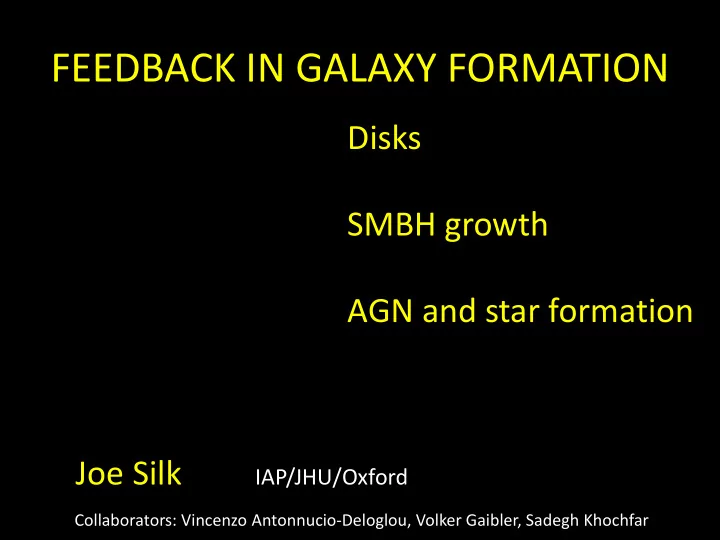

FEEDBACK IN GALAXY FORMATION Disks SMBH growth AGN and star formation Joe Silk IAP/JHU/Oxford Collaborators: Vincenzo Antonnucio-Deloglou, Volker Gaibler, Sadegh Khochfar
Feedback is needed æ ö æ ç ö - 2 a 3 m p t cool T 1 + 2 b M cooled - baryons ~ a g ç ÷ ÷ ç ÷ è ø m e t dyn è ø theory (CDM-motivated) f ( L ) ~ ´ L L 10 3 10 nkT * t cool ~ L T n 2 ( ) 1 observations t ~ dyn Gm n p Reionization Galaxy luminosity/mass Supernovae Tidal stripping SN Active galactic nuclei AGN Infall heating
A GLOBAL STAR FORMATION LAW M33 Grossi et al 2008 Kennicutt et al 2006 SFR=0.02 (GAS SURFACE DENSITY)/t dyn SFE: e = s gas v cool m *,SN / E SN = 0.02 low efficiency due to SN feedback cold gas accretion/global disk instability
But SNe do not eject enough baryons even from dwarfs Baryon fraction Outflow/inflow Powell et al 2011 McGaugh et al 2010
star formation rate/pc 2 100% 1% Starbursts have higher SFE H 2 fraction controls star formation (depends on UV, Z) Star Formation efficiency =SFR/GAS MASS x FREE FALL TIME atomic + molecular gas density/pc 2 Bigiel et al 2009
The angular momentum problem • Bulge/disk ratio is too large due to dynamical friction on dark matter …. causes angular momentum loss of infalling substructures • Solved by SN- driven wind feedback …. but at a price
gas gas Hi SFE Lo SFE Piontek and Steinmetz 2011 stars Agertz 2010
But the disk overheats… House et al 2011
NGC 545 a pure thin disk galaxy Kormendy et al 2010
More massive pure disk galaxies NGC 6946 NGC6503
FEEDBACK BY AGN
AGN are observed to quench star formation…. Schawinski et al Shock-Excited Photoionized Schawinski et al. 2008 Age in billions of years Schawinski et al.2010
Farrah et al 2012 AGN-driven ouflows anticorrelate with obscured star formation
star formation rate is quenched by AGN Antonuccio-Deloglou+ 2010
AGN jet-induced backflow feeds the SMBH 13.10 6 yr entropy contours 30.10 6 yr Antonuccio-Deloglou + Silk 2009
Feedback by massive black holes L Edd /c=GMM gas /r 2 æ ö 4 ç ÷ s M · = 3 ´ 10 9 Msun ç ÷ 300 km ç ÷ è ø s black hole Blowout occurs/star formation terminates s mass when SMBH- relation saturates McConnell et al 2011 velocity dispersion
BH GROWTH AND STAR FORMATION
star formation rate density vs. mass assembly rate Star formation rate density Stellar mass assembly rate Wilkins et al 2008
DOWNSIZING via galaxy stellar mass fraction (centrals) efficiency via abundance matching to z=4 Behroozi 2010
Buried AGN fraction Black hole accretion rate Imanishi 2010 Silverman et al. 2008 Star formation rate density Star Star for orma mation r tion rate te + do + downsizi nsizing ng cor correc ection tion fr from om Beh ehroo oozi zi et et al al 20 2012 12 BH H ac accr cretion etion r rate te x 1000 1000 Buried Buried AGN correction tion ? ?
Active galactic nuclei: aftermath or precursor to star formation? quenching and/or gravity-induced star formation triggering star formation rate x 10 -3 SMBH accretion rate z=1 z=10 redshift
connection between AGN and starbursts Hatziminaoglou 2010 • Netzer 2009 Netzer 2011
Luminous AGN correlate with star formation Lutz et al 2011
Common feeding of SMBH & SF by CO reservoir L bol PAH6 m Xia et al 2012
Specific star formation rate SFR/M star Median SSFR Elbaz et al 2011 Wechsler 2012
Gultekin 2009
momentum-driven AGN winds alone cannot explain the M BH - s relation Unbinding the gas requires h M BH c > M g s Silk & Nusser 2010
FEEDBACK PROBLEMS IN MASSIVE GALAXIES 1) Its not supernovae 2) Its not AGN momentum 3) maybe its both! AGN triggering of star formation
star formation may be triggered by AGN JS and Norman 2009 If AGN-driven outflows trigger star formation, JS + C. Norman 2008 star formation rate boost factor ~ v cocoon / s ~10-100 + outflow momentum amplified by supernovae SFR = e M gas /t ff e SN = s v cool m *,SN / E SN Klamer et al. 2006 z = 4.7 quasar + CO Minkowski’s object H 2 formation triggered by AGN Croft et al. 2006
Intense central UV in PDR [CII]/FIR associated with extreme starburst [CII] Stacey et al 2010
SMBH in z ~ 6 quasars lie high Wang et al 2010
3-d N-body + hydro: RAMSES code (simulations by V. Gaibler, S. Khochfar, M. Krause, JS 2011) 100 pc resolution, 10 cm -3 SF threshold
pressure
stars
UNSOLVED FEEDBACK PROBLEMS IN GALAXY FORMATION How do we form bulgeless (> 15%) galaxies ? How are baryons lost from galaxies ? Are there two modes of star formation ? Why downsizing in Z, M*, SSFR, M BH ? McConnell et al 2011 How are SMBH formed at early epochs ? How are stars formed in extreme environments ?
Recommend
More recommend